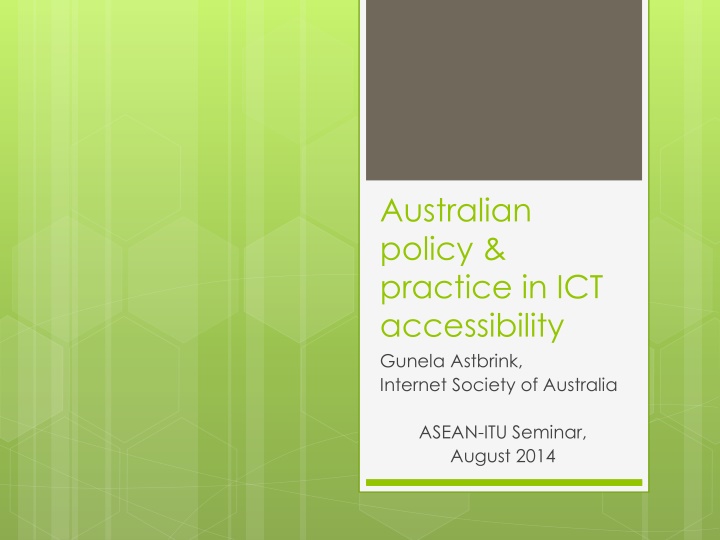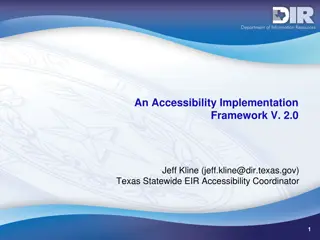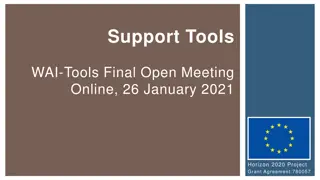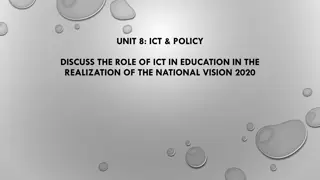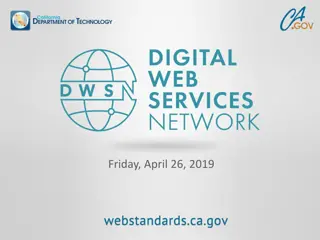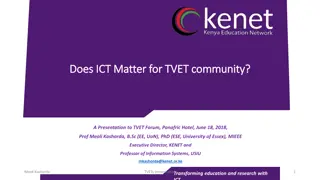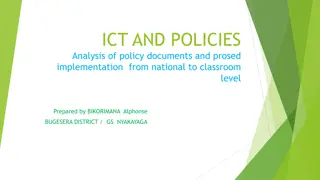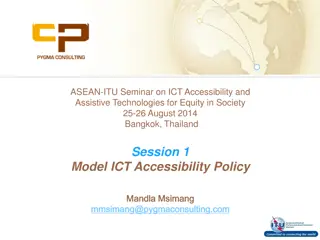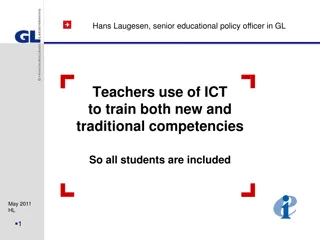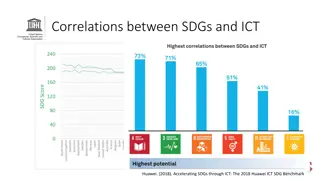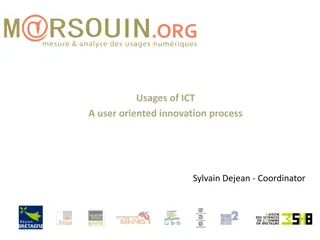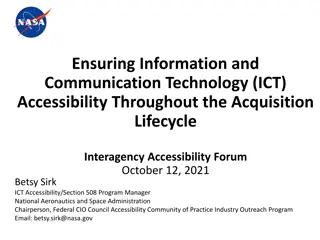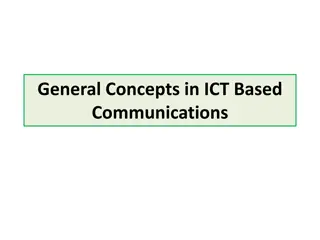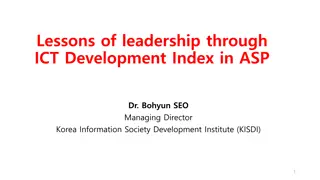Accessibility Policies and Practices in Australian ICT: A Review
Australian policy and practice in ICT accessibility are guided by the UN Convention on the Rights of Persons with Disabilities, with a focus on the Disability Discrimination Act. Initiatives like the National Disability Strategy and Web Accessibility National Transition Strategy aim to create inclusive communities and accessible online platforms. Challenges include the complexity of policy implementation and resource constraints. Progress has been made in making government websites compliant with WCAG standards, but further efforts are needed to meet accessibility goals.
Download Presentation

Please find below an Image/Link to download the presentation.
The content on the website is provided AS IS for your information and personal use only. It may not be sold, licensed, or shared on other websites without obtaining consent from the author.If you encounter any issues during the download, it is possible that the publisher has removed the file from their server.
You are allowed to download the files provided on this website for personal or commercial use, subject to the condition that they are used lawfully. All files are the property of their respective owners.
The content on the website is provided AS IS for your information and personal use only. It may not be sold, licensed, or shared on other websites without obtaining consent from the author.
E N D
Presentation Transcript
Australian policy & practice in ICT accessibility Gunela Astbrink, Internet Society of Australia ASEAN-ITU Seminar, August 2014
Background Australia has signed and ratified the UN Convention on the Rights of Persons with Disabilities Telecommunications legislation refers to Disability Discrimination Act 1992 Well-developed regulatory processes
Policies and practices National Disability Insurance Scheme National Disability Strategy Web Accessibility National Transition Strategy Captioning on TV
Policies and practice Complexity of implementing policy Sometimes, practice takes longer than policies indicate Very important that policies become practice Guidelines to assist implementation
National Disability Strategy 2010-2020 Vision: An inclusive Australian society that enables people with disability to fullfill their potential as equal citizens Strategy 1: Inclusive and accessible communities Relevant areas for future action: 1.7 Promote universal design principles in procurement 1.8 All governments adopted the mandated conformance levels for web accessibility as a baseline requirement to ensure more people with disability have access to online information and services Brings together many planned priorities or activities in the early implementation stage No specific resources allocated
Web Accessibility National Transition Strategy Mandatory for federal government web sites to be accessible to Level AA of WCAG 2.0 by 2014 Web Policy team in Australian Government Information Office (Department of Finance) web accessibility part of whole of government procurement & strategy approach 2010 baseline survey of accessibility on government websites Training and liaison with government agencies Web auditing However, under-resourced in meeting people s expectations
Web Accessibility National Transition Strategy Report on progress 2010-2012 (Report released December 2013) Over 1300 websites 26% of government websites meet Level A up from 5% 46% of sites non-conforming moving directly to Level AA by Dec. 2014 73% of agencies have re-evaluated their web publishing processes 58% have changed their content management systems 97% of agencies are doing an ICT procurement review
Web Accessibility National Transition Strategy Expectation that many agencies will meet Level AA by December 2014 Will not be 100% Difficulty of legacy content Final accessibility survey late 2014 Inclusion is priority beyond 2014
Digital Service Standard Current Government s ICT election policy includes: Convenient service anytime, anywhere Digital Service Standard is planned Adhering to Standard at design stage rather than remediation Moving away from checkbox mentality and shifting paradigm to user perspective Building tools around user needs Self-assessment but new service cannot be launched without meeting Standard (includes WCAG 2.0)
Digital Service Standard Skills development is precursor of Standard Government employees need to acquire digital skills including accessibility to underpin productivity Standard will lead to a Digital Design Guide Accessibility will be included mainstream inclusion approach
National Disability Insurance Scheme Very large Government program for community linking and individualised support 3 Tiers 1. Information & referral 2. Support to access services 3. Individualised care plan for people with significant disability in all facets of person s life
National Disability Insurance Scheme Key principle: Consumer control and choice Support and equipment for education, transport, employment Includes support workers and home modifications ARATA assistive technology policy papers: http://www.arata.org.au/home/disability- care-australia/
Accessibility criteria in ICT public procurement Public procurement = Government purchasing USA apply accessibility criteria when procuring ICT to improve access to their services and employment opportunities for people with disabilities This may have a flow-on effect of greater availability of affordable and accessible ICT
Accessibility criteria in ICT public procurement Significant impact seen in USA through Section 508 eg Apple, Microsoft Completion of European Guidelines to harmonise with Section 508 Research into policy & practice in OECD countries (Astbrink & Tibben) http://telsoc.org/tja/2013-05-v63-n2/a412 Governments sometimes already use suppliers that provide accessible hardware and software but need to specify to acquire accessible sub-sets Australian Government review of Section 508 in terms of its procurement of mobile phones and desktop hardware
Accessibility criteria in ICT public procurement Governments sometimes already use suppliers that provide accessible hardware and software but need to specify to acquire accessible sub-sets Australian Government review of Section 508 in terms of its procurement of mobile phones and desktop hardware
Captioning on TV Broadcasting Services Amendment (Improved Access to Television Services) Act 2012 new captioning targets for commercial and national television broadcasters new captioning obligations and targets for subscription television broadcasters and narrowcasters a requirement that the Australian Communications and Media Authority (ACMA) develop standard(s) on captioning quality
Captioning on TV Broadcasting Services Amendment (Improved Access to Television Services) Act 2012 broadcasters transmit emergency warnings in the form of text and speech, and caption those warnings where practicable new annual compliance reporting and record keeping requirements to support new captioning obligations making compliance with the captioning obligations under Part 9D a licence condition
Captioning & audio description on TV At least 85% of programs from 6.00 am to midnight have closed captions Audio description trialled on ABC (public broadcaster) for 13 weeks in 2012 Successful trial No follow-up service launched
Conclusion Overview of some Australian policies and practices Inclusion is key component Consumers have important role to play to ensure that Government programs remain relevant to their needs
Thank you! Gunela Astbrink Internet Society of Australia g.astbrink@gsa.com.au
